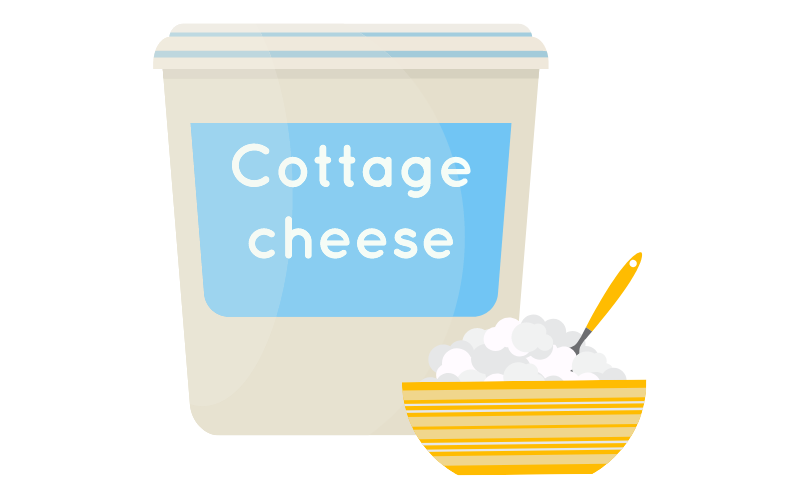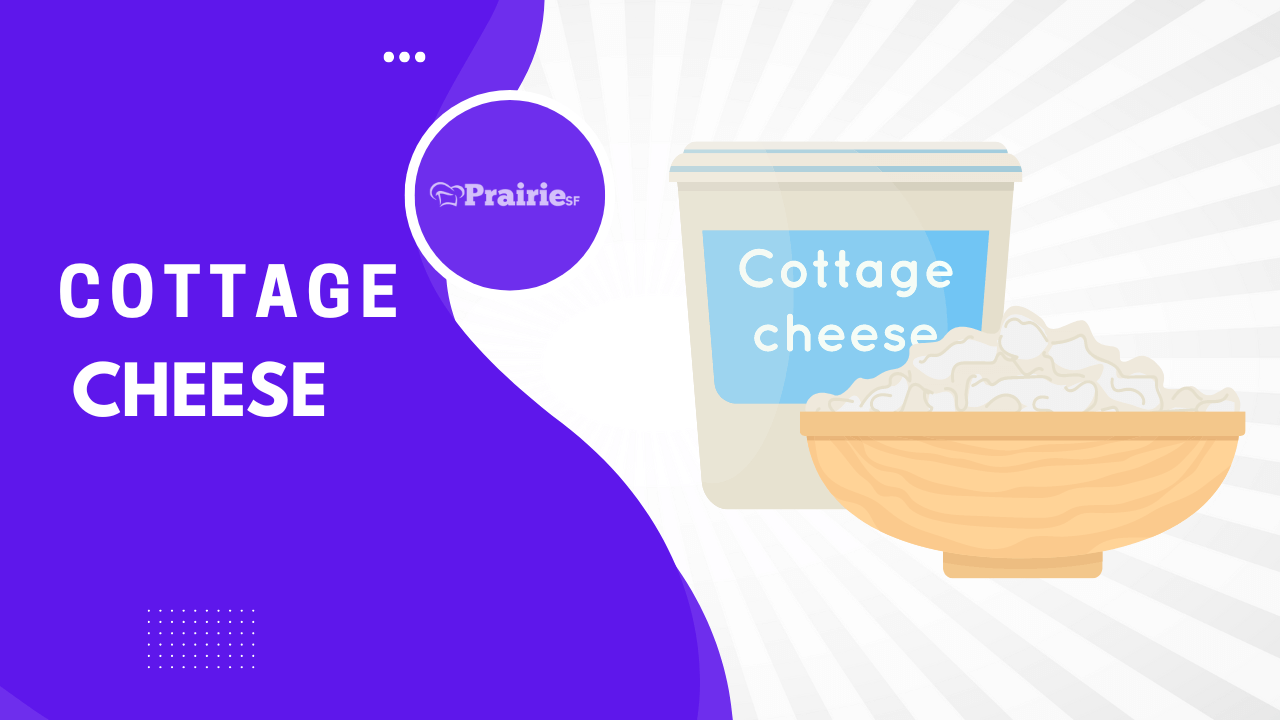Cottage cheese has a mild flavor and is low in calories. Its popularity has risen in recent decades, and it is frequently suggested as part of a balanced diet.
Cottage cheese is high in protein as well as important minerals. It is often used by athletes and in weight loss programs for these reasons.
Being a good source of vitamin B-complex, cottage cheese consumption could help in maintaining good energy levels throughout the day when added to meals.
This article discusses the benefits of cottage cheese and how to incorporate it into your diet, along with its nutrient values that should be generally known to everyone.

Contents
What is Cottage Cheese?
Cottage cheese is creamy, white, and soft. Because it is a fresh cheese, it does not go through an aging or ripening process to create flavor.
As a result, when compared to matured cheeses, it has a fairly mild flavor. Cottage cheese is created from curds of pasteurized cow’s milk in various fat levels, such as non-fat, reduced-fat, or standard milk.
It’s also available in a variety of curd sizes, usually small, medium, or giant. It’s also available creamed, whipped, lactose-free, reduced sodium, or sodium-free.
This versatile cheese can be eaten on its own or as an ingredient in dishes.
How Is Cottage Cheese Made?
Making cottage cheese is a straightforward procedure and could be easily made by anyone. It could be done by following these easy steps-
- The process begins with curdling milk
- This is accomplished by adding an acidic material to heated milk, such as lime juice or vinegar
- Curds of casein protein separate from the liquid part of the milk as the acidity of the milk rises
- The curd is sliced into pieces once set and heated until additional moisture is released
- The acidity is then removed by washing, and the moisture is removed by draining
- As a result, the curd becomes sweeter and crumblier
- Finally, flavors like cream, salt, herbs, and spices can be added to the finished product
Different Kinds of Cottage Cheese
There are several types of cottage cheese that you can prepare at your home or can get from the market which you can easily include in your diet. They are as follows-
-
Dry Cottage Cheese
Dry curd Cottage cheese is a dairy product that consists primarily of uncooked cheese curds. Despite their name, these curds are virtually usually wet.
They are nicknamed “dry” because they lack the liquid basis that most regular cottage cheeses have. Cheesemakers strain dry curd cottage cheese to separate the solids, discarding the whey and any milk run-off.
The curds are widely used in baking and have a mild flavor that complements a wide range of salad and pasta meals.
Dry cottage cheese is a crumbly kind of cottage cheese that is packed immediately after washing, with no liquid added.
Because the microorganisms have broken down the lactose, this cottage cheese is lower in lactose. Lactose-free variants are available.
-
Wet Cottage Cheese
Wet cottage cheese means that milk and/or cream have been added to the curd to make it soupy and spoonable. Because dried curds can be sour, this sweetens the cheese.
Other Varieties
Cottage cheese is popular for its health benefits and is available in 4% milkfat, 2% milkfat, and non-fat variants. Versions that are sodium-free or salt-free are also readily available check the labels.
Cottage Cheese Substitutes
The following are some known cottage cheese substitutes that are commonly eaten by many-
-
Ricotta
Ricotta is similar to cottage cheese and is made up of tiny curd lumps. When opposed to larger curds of cottage cheese, ricotta has a gritty feel. Ricotta, while somewhat higher in calories, is still a very healthful ingredient.
-
Greek Yogurt
Despite its smooth texture, Greek yogurt is a good dairy substitute. It has a similar nutritious profile to cottage cheese.
Strained yogurt or greek yogurt has a rich protein content and is procured after straining all the whey in the process and is called a fermented dairy product.
-
Tofu
Crumbled tofu may create a firmer texture if desired. Tofu contains nearly as much protein as cottage cheese while being lower in saturated fat. It complements the texture of cottage cheese’s solid curds well.
What does Cottage Cheese Taste Like?
Cottage cheese is sweet, mild, and creamy due to the washing and dressing stages. Most variations are also fairly salty; however, the amount of salt varies greatly.
Cottage Cheese Pairings
Cottage cheese goes nicely with a variety of dishes due to its mild flavor. It is commonly used in salads and is also popular as a pancake topping in some areas.
Unsalted cottage cheese goes well with fresh fruit like berries and almonds, whereas salted cottage cheese goes well with fresh veggies like avocado and tomato.
Where to Buy Cottage Cheese
You can purchase fresh cottage cheese from a nearby grocery store or supermarket. It is not a specialty item; thus, it should be available in any cheese aisle or dairy department.
How Long Does Cottage Cheese Last?
Your cottage cheese packaging should have an expiration date or “sell-by date.” If you haven’t opened the sealed container, the cottage cheese will keep for around five days after the expiration date.
It is highly recommended that you should eat it within a week of opening the packet. If you can’t eat it in time, remember that freezing is always an alternative solution.
You can keep the cottage cheese keep in the freezer for about three months and will regain its texture if stirred briskly upon thawing.
How to Make Cottage Cheese
- Fill a big, heavy-bottomed pot halfway with milk
- Heat carefully to 190°F/88°C, frequently stirring to prevent the milk from burning on the bottom of the saucepan
- Remove from heat
- Add vinegar
- Stir several times
- Allow to rest for 30 minutes, covered
- Line a colander with a clean piece of doubled cheesecloth or a tea towel in the meantime
- Place the colander over another bowl to capture any dripping liquid
- Solids from the pot should be spooned into the lined colander
- Allow 30 minutes to drain
- Form a cloth-wrapped ball of cheese by tying the ends of the fabric together securely
- With one hand holding the ball, splash cold water over it, kneading and squeezing it with the other until the entire ball of cheese is cool
- Remove the cheese from the towel and place it in a basin, breaking it up with a spoon
- Season with salt to taste
To make creamy cottage cheese-
- Add 2 tablespoons of heavy cream at a time until the required consistency is reached
- Taste and adjust with extra salt if necessary
- Chill for at least 1 hour before serving
- Stir and serve
Cottage Cheese Nutrition
1 cup low fat (1 percent milk fat) cottage cheese contains the following nutrients:
- 163 calories
- 28 grams protein
- 2.3-gram fat
- 6.15-gram carbohydrates
- 138 milligrams calcium
- 11.3 milligrams magnesium
- 194-milligram potassium (vitamin K)
When you consider its micronutrients like selenium, vitamin B12, riboflavin, folate, and others, the benefits of cottage cheese keep piling up.
Conclusion
Cottage cheese is a mild-flavored curd cheese with a smooth texture. It contains a variety of nutrients, including protein, B vitamins, and minerals like calcium, selenium, and phosphorus.
Cottage cheese is one of the most beneficial foods you can eat whether you want to lose weight or develop muscle. I hope you enjoyed this in-depth look at cottage cheese.
Although the cottage cheese craze peaked a few years ago, there are still a wealth of variations of this multipurpose snack available.

